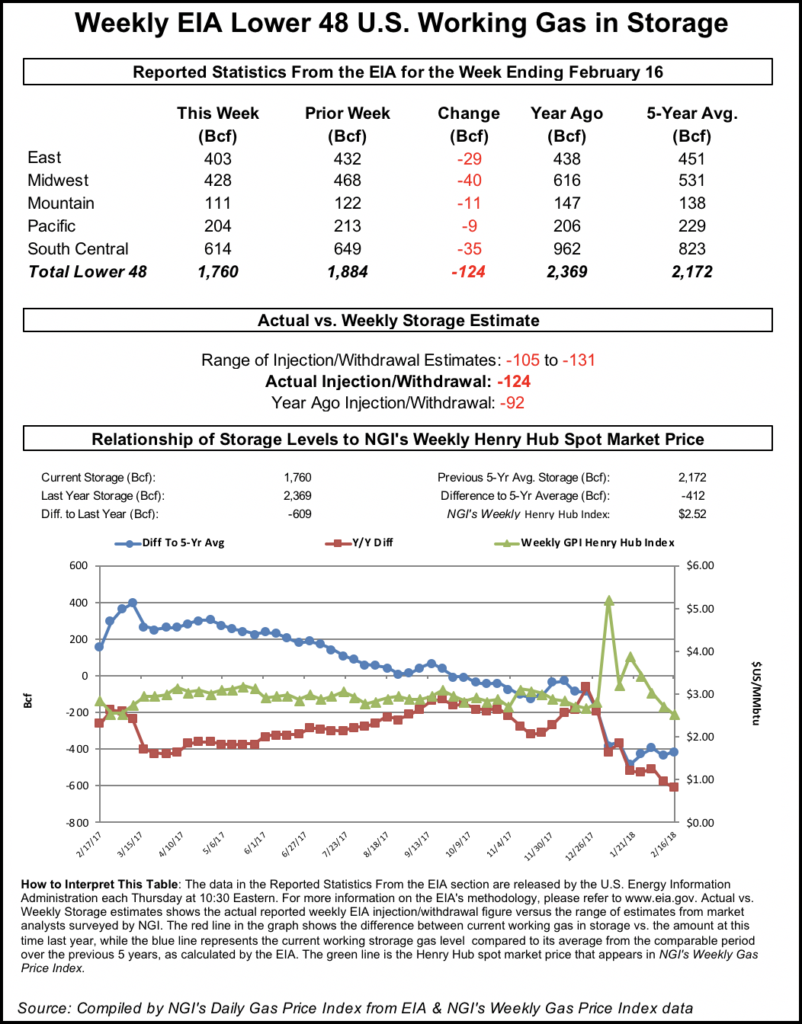Markets | NGI All News Access | NGI Data
EIA Natural Gas Storage Figure Tighter Than Expected, Futures Near Even
The Energy Information Administration (EIA) on Thursday reported a natural gas storage withdrawal that was slightly tighter than market expectations. Futures traded on both sides of even following the news.

EIA reported a 124 Bcf withdrawal from U.S. gas stocks for the week ending Feb. 16, a slightly larger pull than the average predictions leading up to the report. Last year 92 Bcf was withdrawn and the five-year average is a pull of 145 Bcf. Last week, EIA reported a 194 Bcf withdrawal.
As the number crossed trading desks at 10:30 a.m. EDT, the March contract briefly went above $2.660 before pulling back to around $2.640. By 11 a.m. EDT, March was trading around $2.646, down about a penny from Wednesday’s settle.
Prior to Thursday’s report, the market had been looking for a withdrawal close to the actual figure. A Reuters survey of traders and analysts had predicted on average a 120 Bcf withdrawal for the week ending Feb. 16. Responses ranged from -105 Bcf to -129 Bcf. A Bloomberg survey had showed a median -121 Bcf, with responses ranging from -116 Bcf to -131 Bcf.
PointLogic Energy had predicted a withdrawal of 120 Bcf, attributing the smaller withdrawal week/week “to warmer weather in the East and Midwest regions.” Kyle Cooper of ION Energy had predicted a 116 Bcf pull, while Intercontinental Exchange futures for Thursday’s storage report settled at -120 Bcf Wednesday.
“Yet again, this print is quite tight, confirming the tightness that we saw in data last week that kept prices bid against $2.55 support,” Bespoke Weather Services said Thursday. “…With any further gas-weighted degree day additions we continue to see the market as tight enough to rally into the $2.70-2.75 range, with this print only confirming our expectations of market tightness moving into March. Should afternoon model guidance trend colder we could even see $2.70 hit today.”
Total working gas in underground storage stood at 1,760 Bcf as of Feb. 16, versus 2,369 Bcf last year and five-year average inventories of 2,172 Bcf. The year-on-year deficit widened from -577 Bcf to -609 Bcf for the week, while the year-on-five-year deficit shrank from -433 Bcf to -412 Bcf, EIA data show.
By region, 40 Bcf was withdrawn in the Midwest during the week, while 29 Bcf was withdrawn in the East. The South Central saw a withdrawal of 35 Bcf, including 3 Bcf pulled from salt and 32 Bcf pulled from nonsalt. In the Mountain region, 11 Bcf was withdrawn, and the Pacific saw 9 Bcf pulled from storage for the period.
© 2024 Natural Gas Intelligence. All rights reserved.
ISSN © 1532-1231 | ISSN © 2577-9877 |
